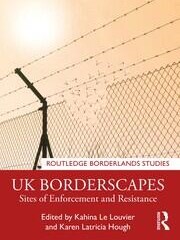About the book
This book analyses bordering practices and their negative effects as well as the many creative and often grassroots ways in which borders are resisted and reinvented.
From the hostile environment to Brexit and the Nationality and Borders Bill, the UK border regime has become increasingly strict and complex, operating both at the edge of the state and within everyday life in unprecedented ways. At the same time, this securitisation approach is often contested, and its effects are fought daily by many groups and individuals. This book explores this tension, documenting and analysing how the contemporary UK border is imagined, constructed, deconstructed, and reconstructed in multiple ways. To draw together the different pieces that compose this evolving and conflicting landscape, this book uses the concept of "borderscapes", which views borders as sites of multiple tensions between hegemonic, non-hegemonic, and counter-hegemonic imaginaries and practices. This lens enables contributors to draw a multifocal overview of the UK border that includes the different human and material actors that form it, the spaces and practices they shape, and the imaginaries and counter-imaginaries that emerge from their conflictual encounters.
Bringing together contributions by researchers from a variety of disciplines, this book will be of interest to scholars and students in the fields of migration and border studies, refugee studies, human geography, criminology, sociology, and anthropology.
Cracks in the UK borderscape imaginary: Opportunism, fluidity, and contradictions in implementing migration controls abroad
This chapter maps the UK’s sprawling network of immigration liaison officers (ILOs), who are posted to foreign jurisdictions and responsible for providing training and ‘capacity building’ to frontline actors incorporated in the UK’s overseas borderscape. It reveals how the borderscape, as it travels abroad, is transformed from the imaginary of a targeted, ‘risk-based’, and effective system of extraterritorial control to one characterised by happenchance, flexibility, and (in)effective working relationships. Drawing on semi-structured interviews with Home Office officials, freedom of information requests, and documentary research, I find the UK’s immigration liaison network, between 2015 and 2020, trained local police, immigration, security, and airline professionals in more than 80 foreign states, spanning nearly all regions of the globe. Despite this sprawling network, I also find cracks that call into question official state narratives of its efficacy and targeted nature – even by UK immigration officers themselves. Instead, realities of implementing migration controls in foreign jurisdictions mean the UK is often subject to uncontrollable local conditions and diverse interests by multiple actors. This chapter exposes these cracks by highlighting contradictions, challenges, and fluidity in the UK’s overseas borderscape as it travels from official statements, policy goals, and imaginaries to the level of implementation abroad.
Full info
Chapter 7: Cracks in the UK borderscape imaginary: opportunism, fluidity, and contradictions in implementing migration controls abroad
Nicole Ostrand
In: UK Borderscapes: Sites of Enforcement and Resistance
(eds)
Routledge (2023)
ISBN: 9781003350255
